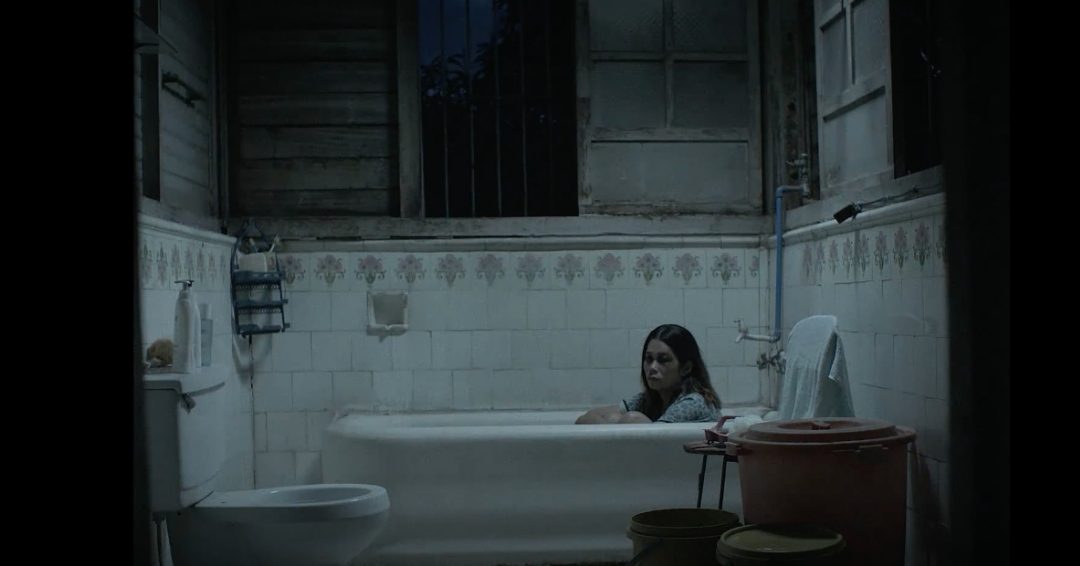SUMMARY
This is AI generated summarization, which may have errors. For context, always refer to the full article.

MANILA, Philippines — The 2018 QCinema Circle Competition ends on Tuesday, October 30 – which entries are worth the watch?
Here’s film critic Oggs Cruz’s take on each film:
Billie & Emma: Loving and living freely
Right from the start, it is clear that Billie (a quietly charismatic Zar Donato) is different.
Plucked from Manila to stay with her aunt (Cielo Aquino) in her provincial house, she begrudgingly dons the standard-issue blouse and skirt her new nun-managed all-girls school requires. Amidst the dainty schoolgirls, Billie, with her masculine haircut and devil-may-care vibe, sticks out like a sore thumb, especially to Emma (Gabby Padilla), the school’s star pupil who in her free time, busies herself alphabetically identifying the cute boys with her best friends.
Emma, however, is more than just the picture perfect girl her school thinks she is. Her mother (Beauty Gonzalez) treats her more like a friend than a daughter. She regularly sleeps with her boyfriend, and eventually gets pregnant. While Billie and Emma first interact when the latter is slighted by the former’s reluctance to be put in the spotlight, the two girls slowly bond, discovering that love is possible despite the circumstances that might hinder it.
Samantha Lee’s Billie & Emma is a captivating romance that works hard for its pleasures. The plot isn’t new. In fact, it borrows its plot points and conflicts from movies that have delighted audiences for decades with their casual depiction of youth-related issues for the purpose of escapist entertainment.
The beauty of Lee’s film lies in its ability to repurpose the familiar tropes to tell a lesbian romance from the perspective of someone who is coming-of-age – an awakening not to the stigma of being different but to the beautiful possibilities of expanding the borders of love.
Like Baka Bukas (2016), Lee’s debut that also featured two girls in love, Billie & Emma relies on moments that visually evoke the purity of its romance, such as the moments when the two lovers frolic on top of a picturesque hill or are swayed to share a tender kiss in Billie’s room. Much more than those moments are the relevant implications of the love that the film uses as its core.
There is more to Lee’s film than just the tenderly told love story of two girls discovering the complications of the world beyond the confines of their school. The film doesn’t just champion the act of loving freely, it also champions the act of living freely in one’s own body, with its abrupt ending generously granting to the viewer the freedom to determine what Emma, a woman first before a lesbian lover, should do while on a bus to the streets of Quiapo.
Dog Days: Hoop nightmares
Timmy Harn’s Dog Days opens with a fevered fantasy of a mother who is about to give up her life for her baby of supposedly half-African American descent. She calls her son Michael Jordan, presumably after the legendary basketball player who she imagines him to become one day.
She dies in a ritual, her blood spread all over Michael Jordan and the box-type Galant she bequeaths to him. With his mother dead and his father somewhere in the States, Michael Jordan (Ybes Bagadiong) is raised by his aunt (Adrienne Vergara), an obnoxiously opinionated woman, with dreams of making the prophecy about his future as a basketball superstar come true.
Dog Days is an addictive shapeshifter of a film. It morphs without warning, seemingly relishing in breaking genre rules and expectations. While it is tempting to think that the delightful inconsistency of its mood is only for the purpose of establishing an esoteric sense of humor throughout the picture, it becomes apparent as the film tenaciously plods along baring its subtly laid themes of half-breeds fulfilling their post-colonial ambitions in a fractured culture that is half-sober and half-high, that everything is by exquisite design.
Shot in monochrome that is at once elegant and bizarre, the film moves with an uncanny confidence. It knows fully well that the directions the narrative is going to are beyond logic and more within the absurd arena of nightmares. It shocks. It exposes desperations and depravities. It does everything with a dollop of cheeky irreverence.
Take away its worthy excesses, Dog Days really is an unwavering and unflinching depiction of an orphan’s search for fame, fortune or some sort of family, which eventually conclusion in the character finding salvation, satisfaction or at the very least some sort of everlasting rest in the mechanical womb of his ever-present mother.
Hintayan ng Langit: Love in limbo
The defining gem of Dan Villegas’ Hintayan ng Langit is the performance of Gina Pareno as Lisang, a soul stuck in purgatory while waiting for her turn to reunite with her husband in heaven. Manolo, played by Eddie Garcia, is new in purgatory and has been assigned to room in with Lisang when his assigned room was discovered to be in disrepair.
As it turns out, Lisang and Manolo have a past and their reunion in limbo has opened an opportunity for them to relive the joys and sorrows of their failed romance. Pareno is the life of this party of the afterlife, breathing levity into a topic that on its own lends to more somber and sober treatment. She spearheads the tricky world building that Villegas and his creative and technical team spend precious resources on.
Verily, with Pareno’s nuanced portrayal of a soul still too burdened with earthly concerns, the film’s celebration of the pleasures and more importantly the pains of being humans defenseless to being in love.
Adapted by Juan Miguel Severo from his one-act play of the same title, Hintayan ng Langit is garbed with all the elements of a crowd-pleaser. It is unapologetically quirky and cute. Depicting purgatory as akin to an airport where the souls are like passengers passing time during their overlong layovers is a lovely touch.
Confined by its imaginative setting, the film eventually struggles to expand its grasp to more than just the unfinished love story of its main characters, with its supporting characters like the various other souls waiting for their trip to heaven never really graduating into anything more than fillers to the central romance.
While the conceit is definitely the film’s greatest strength, it is also its most prominent limitation. For its most part, the film strives but somewhat fails to be more than a poignant parable of the life-long aches that accompany open-ended romances. It is in its conclusion where its characters break the rules of limbo and their earthbound commitments to their spouses that Hintayan ng Langit finally takes flight, graduating from being merely a joyous fantasy into an ode to love’s imperfections and how they trump heaven’s eternal bliss.
Masla a Papanok: Apocalypse then and now
The faults of Gutierrez Mangansakan II’s Masla a Papanok are obvious. There are plenty of technical glitches, exposing that the scope and breadth of the material requires more time and funding. There are entire stretches where the film is blanketed in utter darkness, with a lot of the action rendered completely indecipherable if not for the resourceful sound design that provides the essential information the visuals could not.
However, there are also sequences in the film that are absolutely lyrical, with Mangansakan making most of his resources to recreate images that evoke a forgotten past. While the actors and actresses that Mangansakan assembled to portray his characters seem to lack both skill and experience to churn out memorable performances, they possess the look to complete the film’s demanding aesthetic. Quennie Lyne Demoral, with her striking eyes and distinct features, creates a compelling dissonance in the convent where her sudden presence represents a turning point in the history Mangansakan is presenting.
Masla a Papanok feels like an elegy to pristine cultures snatched by conversion and conquest that are part and parcel of colonization. Mangansakan again sheds a light on a history often neglected by the zeitgeist.
The film is a plea against forgetting, with its provoking parting shot involving characters succumbing to dementia encountering the ominous titular bird serving as a warning against the experiences of the past simply fading into obscurity. Masla a Papanok imagines the apocalypse not as a literal end of the world but ends of eras where cultural identity is forced to surrender to subservience, violence and painful obsolescence.
Oda sa Wala: Filling the void
Each immaculate frame of Dwein Baltazar’s Oda sa Wala tells a story. The first frame has mayflies crowding a lightbulb, with a recording of Chinese folk song Mo Li Hua playing in the background. The second frame shows Sonya (Marietta Subong), alone and lying on her bed, listening to the folk song. Her father (Joonee Gamboa) walks in and without saying a word, turns the lights off and leaves the frame. Sonya gets up from bed, switches on the lights, and continues to listen to her song.
With just a few frames, Baltazar has already conveyed so much. She has depicted loneliness that doesn’t stem from simply being alone but from being unable to reach out to her loved ones. She has portrayed a forlorn woman whose only comfort at night are the light that attract hordes of mayflies and a lovely melody sung in a foreign language.
Baltazar, however, isn’t content in simply depicting loneliness or a figment of a family that is reduced to heartless routine. She adds a corpse into the mix and elevates the discourse, turning each of cinematographer Neil Daza’s unsettlingly still and perfect frames into penetrating glimpses of a brutalizing void.
It is a horror picture, through and through. While the corpse that Sonya uses to keep her company is truly grotesque and terrifying, it is the glaring emptiness that ultimately distorts her and convinces her that death is a more satisfying companion than the living that is indelibly haunting.
Twisted but still very human, Sonya, as portrayed by Subong, is endearing in her bid out of desolation. There is still mirth in her existence, or at least in the way she opts to appear to her funeral house’s customers and most especially to the taho vendor she fancies as a possible escape from her loneliness.
It is during the moments where everything disappears that she exposes her fragility. The compelling strangeness of Oda sa Wala steadily grows as it subtly reveals more of Sonya’s story through the minute conversations she shares with a cadaver or the tender moments she redeems from her distant father.
The film is bleak but poignant. It is visually rich and intricate, but its real power lies in the fact that there is so much Baltazar doesn’t reveal, and that ingenuously crafted void perturbs, disturbs and provokes. —Rappler.com
(Editor’s note: The writer was part of the jury for the main competition of the festival)

Francis Joseph Cruz litigates for a living and writes about cinema for fun. The first Filipino movie he saw in the theaters was Carlo J. Caparas’ Tirad Pass.
Since then, he’s been on a mission to find better memories with Philippine cinema.
Add a comment
How does this make you feel?
There are no comments yet. Add your comment to start the conversation.